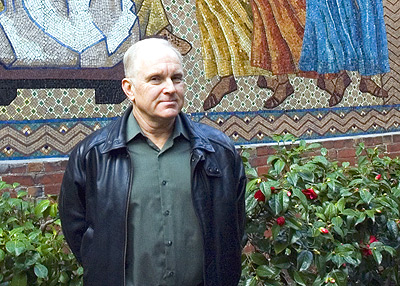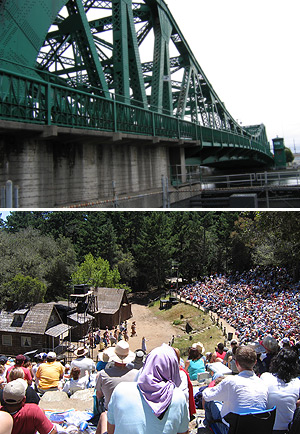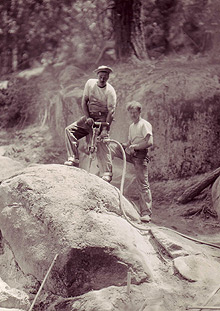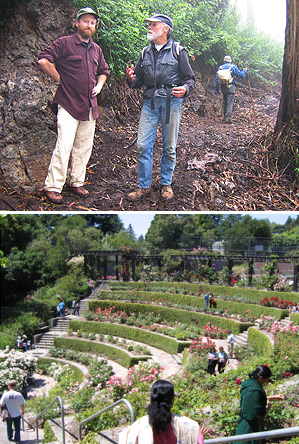Berkeleyan
 |
Among the New Deal projects being inventoried by Gray Brechin, left, is a WPA mosaic adorning the old University Art Gallery, a former power house north of Sproul Hall. (Wendy Edelstein photo) |
New life for the New Deal
Revered, reviled, and largely forgotten, the public-works legacy of the FDR era is all around us - and the Living New Deal Project is drawing the map
![]()
| 16 January 2008
When Gray Brechin set out to document the New Deal's legacy in California, the mission seemed modest enough. Little did he know. What began as a two-person effort - just him and a photographer - has since morphed into a kind of community-based archaeological expedition, a collaborative act of physical, spiritual, and political reclamation in which the university and the state's residents are vital partners.
"I liken it to coming across a ruin in a jungle and starting to dig and you find it's not only a building, it's a city, and then you find it's an entire civilization that's been buried and forgotten," says Brechin, a widely known "historical geographer" who earned his bachelor's, master's, and Ph.D. at Berkeley and is now a visiting scholar here. "In this case it's our civilization, it's something that we did."
 From art to infrastructure, the New Deal's legacy is very much alive - if not always recognized - here in Northern California. Projects include, top, Alameda's Park Street Bridge, courtesy of the Public Works Administration, and bottom, the Mountain Theater in Mount Tamalpais State Park (Civilian Conservation Corps). (Gray Brechin photos) |
Just 75 years after Franklin Delano Roosevelt took the oath of office in March 1933, Brechin believes America has largely "buried and forgotten" what the New Deal meant to a nation suffering mightily under the weight of the Great Depression - even though, as he's discovered, we're still reaping the benefits in the form of public art, park trails, golf courses, amphitheaters, school buildings, hospitals, bridges, streets, sewers, and aqueducts. During a 10-year period, millions of out-of-work men helped build physical infrastructure with the federal Civil Works Administration, Public Works Administration, and Works Progress Administration; "boys" age 18 to 25 did their bit for family and country by joining the Civilian Conservation Corps, which was dubbed Roosevelt's "tree army."
Much of that infrastructure has fallen into disrepair, and veterans of the CWA, PWA, CCC, WPA, and other alphabet-soup agencies are a rapidly dying breed. Meanwhile, the social safety net created in the wake of the U.S. economy's 1929 collapse has come under increasing fire in what Brechin calls "a long war on the New Deal" dating to the Republican presidency of one-time FDR Democrat Ronald Reagan, and carried on today by proponents of further deregulation and privatization. "The goal was to essentially do away with the last vestiges of the New Deal," he says, "and they've been largely successful."
Enter the Living New Deal Project. Brechin and photographer Robert Dawson launched the enterprise in the fall of 2003 - when the state of the nation had plunged Brechin into a depression of his own - under the auspices of the California Historical Society, and with help from a seed grant from the Columbia Foundation. But the New Deal's reach was too vast, and federal records too scarce and scattered, for such a humble effort.
"I realized I couldn't do it myself," Brechin says. "It had to be people all over California working collaboratively," in an echo of the New Deal itself. He turned to the campus's Institute for Research on Labor and Employment and the California Studies Center, which teamed up to take over the project's website. Designed and managed by volunteers, the site had been built around a "mash-up" - a database-driven system that could display research on New Deal sites on a dynamically created map - created by Jay McCauley, a retired Silicon Valley software-engineering director.
 CCC “boys” building an access road in Sequoia National Park. (CCC archival photo) |
The IRLE Library, which oversees Web services for the labor institute, has substantially boosted the site's interactivity, security, and longevity, rewriting its patchwork code in a single, open-source programming language and moving it to the university's server. Terry Huwe, the library's director, says the revamped site "enables volunteers everywhere in California to contribute material to the Living New Deal Project," from photos and journals to information on the locations of physical artifacts throughout the state.
"We had the know-how. What we wanted to do was extend the library's expertise in organizing information to a wide-open volunteer community," Huwe says. "It's an exercise in building Web resources, but also in building interactive community, which is what Web 2.0 is all about."
Talking back to an electronic guidebook
The searchable, online database is designed to let visitors see the legacy of the New Deal in their communities - an "electronic guidebook" featuring a digital, clickable map - and to enable anyone with information about local projects to "talk back" by entering data themselves. Volunteer-provided research will be vetted for accuracy and quality by grad students in the California Studies Center under the direction of its chair, geography professor Richard Walker.
Economics professor Michael Reich, the IRLE's director, believes Berkeley is an ideal setting for such an enterprise. Noting the New Deal's "pervasive influence on American society," he says the period holds interest for researchers from a variety of disciplines, adding that the project "uses new technology to expand access beyond the campus."
 At top , modern-day volunteers restore an old WPA-built trail on Mount Sutro, in San Francisco; at bottom, the Berkeley Rose Garden, where a bronze plaque reads "Constructed by Works Progress Administration, 1937." (Gray Brechin photos) |
To Brechin, a California native who's written extensively about the state and its history, the lessons of the New Deal are unmistakable and deeply personal. In the wake of 9/11 and the U.S. invasion of Iraq, he explains, "I was just headed down the road to complete despair. This has really saved me. I want to give that to other people who are involved in the project. Because it gives you a glimpse of an alternate reality.
"It's not utopia," he's quick to add. "We actually achieved this. And it's astounding what we were able to achieve, and what you can achieve when you've got something we've forgotten about, which is compassionate and ingenious leadership. It's been so long since we've had that, and most of the people who've experienced it are dying away."
His lectures, Brechin says, "come as a thunderclap to students," many of whom have grown up with little knowledge of the era or its accomplishments.
In that respect, they're not unlike Brechin himself, who seems just as surprised by the magnitude of his modest dig through the New Deal's bounty. "I've been learning from the moment I got started," he says. "And it's been the most wonderful and overwhelming experience of my life."
To learn more about the Living New Deal Project - or to find the locations of New Deal sites in California - visit the project website at livingnewdeal.berkeley.edu.

